Thinking of adding a Beagle to your family? Known for their cheerful dispositions and love of adventure, Beagles make great companions. But before you commit and bring one of these pups home, it’s crucial to do your research and make sure the Beagle breed is right for you. This blog post will cover everything you need to know about Beagles, from their history, physical characteristics, and temperament to their exercise needs, common health problems, grooming needs, and more!
Beagles are small- to medium-sized dogs originally developed for hunting rabbits and hares. They are part of the hound group, developed in England, and are similar in appearance to Basset Hound and Foxhound. In fact, they are often mistaken for these two breeds.
These pups have a sharp sense of smell and love to follow their nose, which is why they were, and still are, the top choice for small game hunting. Their superior tracking abilities have also made them popular search-and-rescue dogs and detection dogs or sniffer dogs for narcotics and explosives.
Beagles have long been a favorite among dog lovers for their friendly, outgoing personalities and adorable looks and have been winning hearts for centuries. Even to this day, their popularity remains unwavering, maintaining a spot in the top 10 most popular dog breeds in the United States.
This isn’t surprising whatsoever when you consider all that the Beagle has to offer. Beyond their endearing faces and puppy dog eyes, they are relatively low-maintenance dogs that are easy to care for. They also get along well with children, people, and other dogs, making them excellent family pets. Plus, because of their small size, they are a good choice for those who live in apartments or small homes.
Whether you’re already head-over-heels in love with Beagles and considering adding one to your family, or you’re simply curious about this breed, read on to learn everything there is to know about these merry little dogs!
| An Overview of Beagle Breed Characteristics | |
|---|---|
| Weight | 18 - 35 pounds |
| Height |
Come in two varieties: 13 inches & under 13 - 15 inches |
| Life Expectancy | 10 - 15 years |
| Coat Type | Smooth, dense double coat |
| Colors |
Multi-colored, and the color combinations can include white, black, tan, brown, red, blue, lemon, and orange |
| Breed Size | Small- to medium-sized dogs |
| Breed Group | Hound |
| Bred For | Rabbit & Hare Hunting |
| Affectionate With Family | 5.0 out of 5.0 stars5.0 |
| Good With Children | 5.0 out of 5.0 stars5.0 |
| Good With Other Dogs | 5.0 out of 5.0 stars5.0 |
| Friendly Towards Strangers | 4.0 out of 5.0 stars4.0 |
| Breed Health | 3.0 out of 5.0 stars3.0 |
| Shedding Amount | 3.0 out of 5.0 stars3.0 |
| Grooming Needs | 3.0 out of 5.0 stars3.0 |
| Adaptability | 4.0 out of 5.0 stars4.0 |
| Trainability | 3.0 out of 5.0 stars3.0 |
| Prey Drive | 5.0 out of 5.0 stars5.0 |
| Playfulness | 5.0 out of 5.0 stars5.0 |
| Protective Nature | 2.0 out of 5.0 stars2.0 |
| Energy Level | 4.0 out of 5.0 stars4.0 |
| Apartment Living | 3.0 out of 5.0 stars3.0 |
| Good for First-Time Dog Owners | 3.0 out of 5.0 stars3.0 |
| Tolerate Being Left Alone | 1.0 out of 5.0 stars1.0 |
| Cold Tolerance | 2.0 out of 5.0 stars2.0 |
| Hot Tolerance | 4.0 out of 5.0 stars4.0 |
| Tendency to Drool | 1.0 out of 5.0 stars1.0 |
| Tendency to Bark | 5.0 out of 5.0 stars5.0 |
| Tendency to Snore | 2.0 out of 5.0 stars2.0 |
| Tendency to Dig | 3.0 out of 5.0 stars3.0 |
| Exercise Needs | 4.0 out of 5.0 stars4.0 |
| Mental Stimulation Needs | 4.0 out of 5.0 stars4.0 |
| Puppy Costs | 3.0 out of 5.0 stars3.0 |
Breed History & Origin
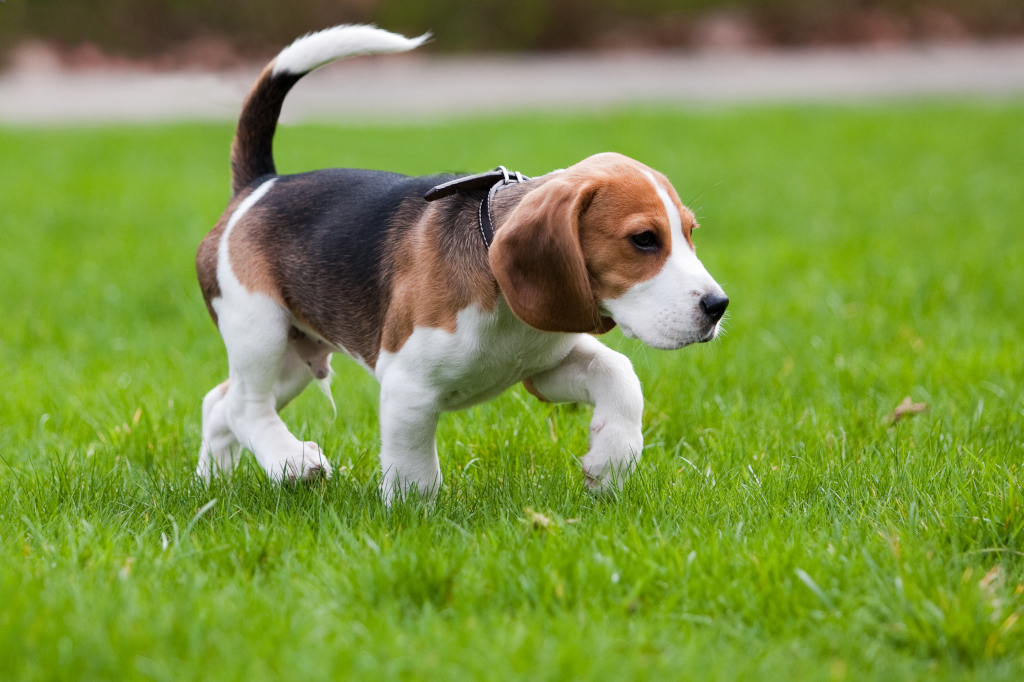
The Beagle’s exact origins are unclear, but one thing is for sure: they have been around for a long time. In fact, the earliest recorded mention of hunting hounds similar to the Beagle dates back to the 5th century BC in Greece. However, the Beagle as we know it today didn’t exist until much later.
According to the National Beagle Club of America (NBCA), William the Conqueror brought the now-extinct Talbot Hounds to England during the Roman Conquest of Britain in 1066. These dogs were used to create the Southern Hound, which is thought to be an ancestor of the modern-day Beagle.
The term “Beagle” is thought to be derived from the Old French word “begueule,” which means “open throat” or “loud mouth“, referring to the breed’s distinct baying and howling sound these dogs make when hunting.
There’s another theory that suggests that the word “Beagle” comes from the Gaelic word “beag,” meaning “small.” In fact, there was a type of well-established small scent hounds called “Pockets Beagle” or “Glove Beagle” that were only about 9 inches tall during the Medieval period. These dogs were bred to be small enough to fit into a hunter’s gauntlet, pocket, or saddlebag so they could be easily transported to wherever the hunt took place.
These tiny glove-sized dogs were very popular among the English nobility. Queen Elizabeth I reportedly kept a pack of these Miniature Beagles for amusement, and she even called them “singing beagles” because of their melodious voice. King Henry VII was also known to admire these toy-sized dogs.
However, the Pocket Beagle eventually fell out of favor with the aristocracy in the 18th century as fox hunting became more popular. And that’s because Glove Beagles were simply too small to keep up, so they were largely replaced by larger and much faster hounds better suited for the job. Nevertheless, hare hunting was still popular with the farmers in England, Wales, and Ireland during that time. So this line of mini Beagles survived a little longer until the early 1900s, when they sadly eventually became extinct.
In the 1700s, there were two new breeds developed in England for hunting rabbits and hare. These were the North Country Beagle and the Southern Hound. The Southern Hound was a large, slow, heavy-set dog, while the North Country Beagle was a smaller, faster dog with poorer scenting ability.
And remember I mentioned earlier that fox hunting became more popular in the 18th century? Well, it was around this time that North Country Beagles and Southern Hounds were used to cross with larger hound breeds to create a new, improved line of dogs for this type of hunting, and these new perfect fox hunters became known as Foxhounds.
Fast forward to the mid-19th century, Reverend Philip Honeywood started breeding a small pack of Beagles in Essex, England. It’s believed that Honeywood’s Beagles played a significant role in developing the modern-day Beagle breed. Though no concrete evidence, North Country Beagles and Southern Hounds were also involved in the mix.
Around the same time, a man named Thomas Johnson wasn’t satisfied with the look of Honeywood’s Beagles and had produced Beagles that were also great hunters but with a more refined appearance.
In the early 1870s, General Richard Rowett of Illinois imported some good-looking Beagles from England, intending to improve the breed’s appearance further and produce a quality bloodline. Rowett’s Beagles are believed to have created the models for the first American standard, and in 1885, the American Kennel Club officially recognized the Beagle as a breed.
Size & Appearance
Beagles have two different varieties: the 13-inch and the 15-inch in height at the shoulders. The 13-inch Beagle usually weighs between 18 and 25 pounds, while the larger 15-inch version can tip the scales at 30 to 35 pounds.
Beagles are compact, muscular dogs with a deep, broad chest and a level topline. Their heads are slightly domed and have a square-shaped muzzle. They have big, dark brown or hazel eyes that are set well apart and have a pleading expression. And their ears are long, moderately low-set, and floppy.
The Beagle’s hips and thighs are well-muscled, and the stifles (knees) are strong with firm hocks. Their tail is set high, slightly curved, and carried merrily, usually white-tipped so hunters can easily see them when they pursue their prey through narrow spaces and thick underbrush.
Color, Coats, & Markings
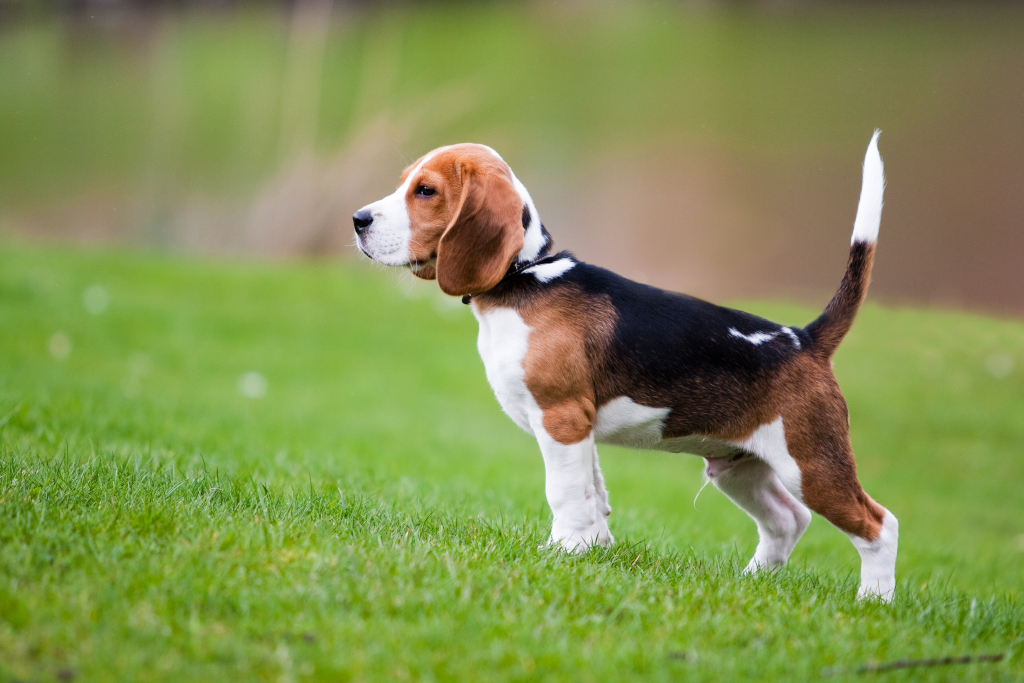
The coat of a Beagle is medium length, dense, and smooth. Beagles are typically multi-colored, either tri-colored, bi-colored, or ticked, and they can come in a wide range of patterns and colors, including white, black, tan, brown, red, blue, lemon, and orange.
Any color is acceptable as per the breed standard, and some of the color combinations you’ll see are:
- Black, Tan, & White (most popular)
- Black, Red, & White
- Blue, Tan, & White
- Black & Tan
- Brown & White
- Red & White
- Tan & White
- Lemon & White
- Orange & White
Temperament
Beagles are friendly, curious, and outgoing dogs that love having fun! Also known for their gentle, sweet, and cheerful dispositions, Beagles are often referred to as the “happy-go-lucky” breed and will get along with just about anyone they meet. In fact, you’ll often see them welcoming strangers with a wagging tail and a happy smile, so they aren’t good guard dogs.
It’s also crucial to keep in mind, though, that Beagles are scent hounds. And as such, they have a strong instinct to follow their noses. This can lead them into trouble if they catch a scent of something interesting, as they will take off after it without a second thought, though it won’t be hard to find them because these merry little hounds will surely be baying loudly as they go and let you know where they are!
While some see this as a negative trait, others find it endearing and simply part of the Beagle’s charm. Either way, it’s vital to be aware of this and ensure your Beagle is always on a leash whenever outdoors.
And because of their strong prey drive, Beagles aren’t the best fit for homes with smaller pets such as rabbits, hamsters, and guinea pigs. They’ll be very tempted to bother, if not chase and catch, these little creatures and see them as nothing more than a fun toy to play with or a delicious snack!
That said, Beagles get along splendidly with other dogs and love playing and romping around with their canine buddies. They also love to please, get along well with kids, and enjoy the company of their human family, making them excellent pets for homes with small children.
Living Needs
As the old saying goes, don’t judge a book by its cover! Though Beagles may look like couch potatoes, these little hounds have a lot of energy and need plenty of exercise. Therefore, they’re best suited for active families or those with a big backyard where they can run and play to their heart’s content.
Because of their urge to wander off and follow their noses, Beagles will find ways to escape in search of an interesting scent, so a fence is a must. Ensure the fence has no gaps or holes your little escape artist can squeeze through. And if possible, opt for a 6-foot privacy fence as Beagles are adept climbers and will happily scale a shorter fence in pursuit of something interesting on the other side! Alternatively, consider installing an underground dog fence to keep your Beagle safe and sound at home. Also, it’s a great idea to invest in a GPS tracking collar, just in case your little Houdini does manage to make a break for it!
While homes with a large yard offer Beagle a better opportunity to burn off some energy, they can do just fine in smaller houses and apartments so long as they get adequate daily exercise. Meaning you’ll need to make an effort to take your Beagle out for walks and playtime more often to help them burn off any excess energy.
Also, one thing to note is that Beagles don’t tolerate cold weather well. So if you live in a state with cold winters, like Alaska, North Dakota, or Minnesota, you’ll want to dress them warmly in a coat or sweater and put booties on them when taking them outdoors during the colder months. You would also want to provide them with a warm, cozy heated bed to curl up in when the temperatures drop.
This breed also craves companionship and loves being around their human family because they’re bred to work in packs. As such, they don’t do well when left alone for long periods and can become anxious and destructive. If you work long hours and are frequently away from home, consider hiring a dog walker or dog sitter to come over and keep your Beagle company.
You May Also Like: 10 Ways to Exercise Your Pup Indoors this Winter
Exercise Needs
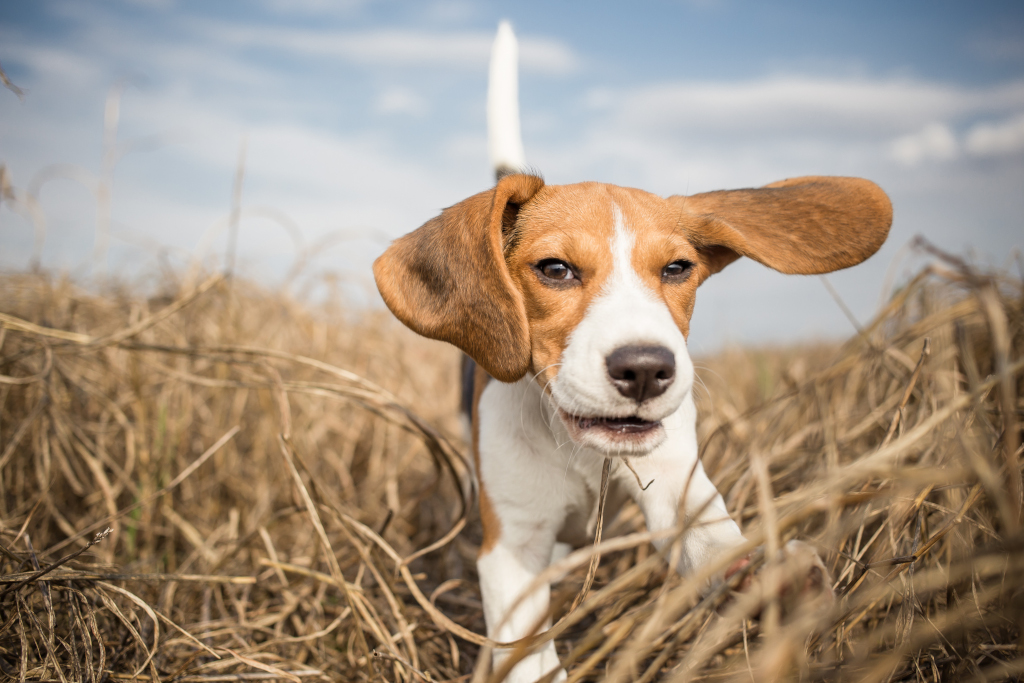
It’s not surprising that Beagles have high energy levels and require plenty of exercise since they are a hunting breed. And it’s important to keep them well-exercised and mentally stimulated, or else you may find your little hound chewing on your shoes or furniture and digging holes in your yard, which is the last thing you want.
Ideally, Beagles should have at least an hour of exercise every day, though they’ll be happy with more if you can give it to them. This can be a combination of walks, playtime in the backyard, or trips to the dog park. If you live an active lifestyle, taking your Beagle with you on hikes, bike rides, and jogs would be the perfect way to get them the exercise they need.
They’ll also appreciate the off-leash time to run and play freely. If you have a fenced-in backyard, then that’s great. If not, regular trips to the dog park or other safe off-leash areas will do the trick. Just make sure to keep an eye on them as they may escape in pursuit of an interesting scent!
And when it comes to mental stimulation, interactive toys and puzzles are a great way to keep their minds challenged and engaged. Hide-and-seek, “find the treat,” and other games that require them to use their nose to find something or someone are also excellent options.
Beagles are at their best when they have a job. So if you can find ways to incorporate their exercise needs into some sort of work or play, they’ll be all the happier. For instance, you can enroll them in nose work classes. Or better yet, teach them to hunt with you!
Training
Beagles are a notoriously stubborn and hardheaded breed. Plus, they have selective hearing and will often choose to ignore you once they’ve caught a scent. So training can be a bit of a challenge, especially for first-time dog owners. You can’t blame them, though, as that’s what they’re bred to do, and that’s exactly why they make such great hunting dogs, determined to follow a scent until they find their prey.
That said, Beagles are not impossible to train. It will only require patience, consistency, and positive reinforcement, meaning you’ll want to praise and reward them whenever they do something right. And the earlier you start the training, the better and best to begin while they’re still puppies. This will help instill good manners in your pooch and ensure they grow into confident, well-rounded adults.
Puppy kindergarten and obedience classes are an excellent way to socialize them and teach them basic commands like sit, stay, come, down, off, and leave it. Of course, you’ll want to continue practicing these commands at home so that they become second nature to your dog. And once they have a good grasp of the basics, you can move on to more advanced tricks. Just remember to keep training sessions short and sweet as they have relatively short attention spans.
One final note on training is to master the “come” command because, as mentioned earlier, Beagles tend to take off after anything that catches their interest, without a care in the world for your calls. So, being able to recall them in any situation reliably is especially essential to keeping them safe.
You May Also Like: The Common Myths About Shock Collars
Health
Beagles have a life expectancy of 10 to 15 years and are generally a healthy breed. However, like all dogs, they’re susceptible to certain health problems. And the most common health conditions to watch out for include:
- Cherry Eye. This is a condition where the gland in the third eyelid prolapse or pops out. While it usually doesn’t cause extreme pain, it can be irritating and uncomfortable for your dog, which may cause them to paw at their eyes, resulting in further irritation. And if left untreated, it can lead to more serious problems like conjunctivitis or corneal ulcers. Fortunately, cherry eye is very easy to spot (a tiny red or pinkish cherry-like mass in the corner of your dog’s eye) and can be treated with minor surgery.
- Achondroplasia (dwarfism). This is a genetic disorder that leads to dwarfism. Beagles with this condition have a short neck, large head, crooked legs, and an awkward gait. It’s a painful condition that can cause mobility issues, and affected dogs are more prone to developing joint and back problems later in life. While there’s no cure for dwarfism, they can still lead relatively normal, happy lives with the help of pain medication and special care, for instance, by providing them with ramps to help them get in or out of the car.
- Epilepsy. Epilepsy is a neurological disorder that causes recurrent seizures. Causes can include head trauma, metabolic disturbance, or a genetic predisposition. There is also idiopathic epilepsy where the cause is unknown. Beagles with epilepsy usually start experiencing seizures between 18 months and five years of age. Some might only experience it for a few seconds, while some might suffer from it for a minute or two or even longer. And those that have seizures lasting more than five minutes or multiple seizures in a short time are at risk of developing brain damage and can potentially die. Regardless, you’ll need to work closely with your vet if your dog has epilepsy so that they can diagnose the underlying cause and treat it accordingly.
- Hip Dysplasia. Hip dysplasia is commonly seen in large breeds but can also affect breeds like the Beagle. This is a condition where the ball and socket joint in the hips doesn’t fit together correctly, leading to pain and lameness and can cause arthritis later in life. It’s often genetic but can also result from other factors like improper nutrition, traumatic injury, and too much exercise when they’re young. There are many different surgical treatments for hip dysplasia, though they are very expensive. So, it’s best to focus on prevention by ensuring your pup gets proper nutrition and exercise and buy your Beagle from a reputable breeder who screens for the condition.
- Hypothyroidism. Hypothyroidism is when the dog’s thyroid gland doesn’t produce enough hormones, resulting in unexplained weight gain, lethargy, and other health problems. It is typically caused by an autoimmune disease, in which the body’s immune system thinks the thyroid gland is a foreign invader and attacks it. Hypothyroidism can be treated with medication, but it’s a lifelong condition that requires regular monitoring and continuous supplementation of FDA-approved drugs.
- Intervertebral Disc Disease (IVDD). IVDD is a condition where the discs in your dog’s spine degenerate and herniate, rupture, or slip, which can cause severe pain and may even lead to irreversible nerve damage and paralysis. While it’s an age-related condition, over-exercising, trauma, and being overweight can contribute to its development. Treatment options range from conservative (rest, medication, physical therapy) to surgical (removing the disc pressing on the spinal cord). One thing to note, even with surgery, not all dogs make a full recovery and may not regain the ability to walk. In cases like this, you’ll need to provide them with dog mobility aids like a cart or wheelchair to help them get around.
- Musladin-Lueke Syndrome (MLS). Previously known as Chinese Beagle Syndrome (CBS), Musladin-Lueke Syndrome is a genetic disorder that affects the structure of connective tissues and can affect multiple organs, including the skin, muscle, bone, and heart. More often than not, Beagles with MLS have short, upright front toes and walk on their tiptoes, looking like a ballerina. They also have a flattened head, folded ears, slanted eyes, and tighter skin, often appearing less scruffy and more muscular, and some may also have a kinked tail. Unfortunately, there’s no cure for MLS, but you can help maintain a positive quality of life for your pup by providing them with proper management and care.
- Patellar Luxation. It’s a condition where the kneecap (patella) slips out of the groove it’s supposed to be in, causing your dog pain and lameness. It’s often seen in small breeds, and dogs with this condition are predisposed to developing other knee injuries like a torn cruciate ligament. When the patella dislocates, you’ll see your dog holds their leg up and won’t put any weight on it. Or they’ll stretch or extend their leg to try popping the kneecap back in place. Treatment for patellar luxation can range from weight management, pain medication, and exercise restriction, to surgery, depending on the severity of the condition.
Nutrition and Feeding
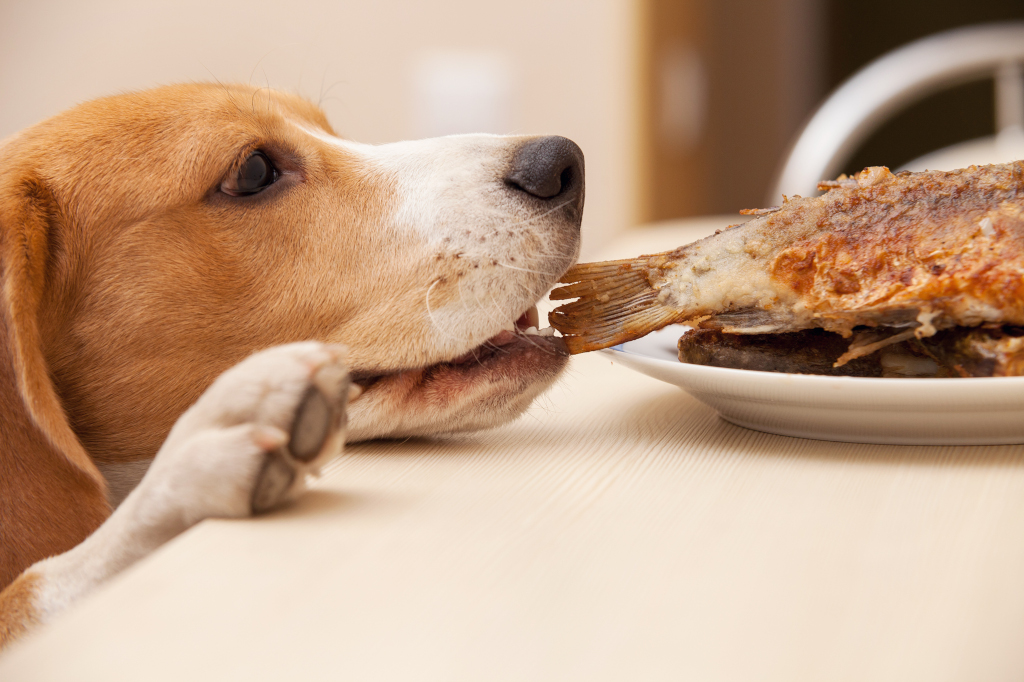
Beagles are not picky eaters, but that doesn’t mean you should just feed them anything. Like all dogs, they need a balanced diet to stay healthy and fit. The best way to ensure your Beagle is getting everything they need is to feed them high-quality, nutritionally balanced dog food that consists of real meat. Avoid food that’s high in filler ingredients like corn, wheat, and soy.
When it comes to how often to feed your Beagle, puppies need to be fed three times a day until they’re six months old. Then, you can switch to two times a day. Ensure that you feed them age-appropriate food as puppies have different nutritional needs than adult dogs.
As for how much food to give, Beagles generally need about 1 to 1.5 cups of food per day. But this varies depending on the individual dog. For instance, Beagle puppies need roughly 55 calories per pound of their body weight per day, while adults need about 45 calories per pound. And if your pup is particularly active, you will need to feed them more since they’ll burn more calories. Similarly, if they’re less active, they’ll need less food. So make sure to adjust their food intake as needed.
One last thing to keep in mind is that Beagles will eat anything and everything they can get their paws on. They are known to be gluttons and have a voracious appetite. They’ll beg for food, try to sneak a snack from the table, or even help themselves to the trash can, and they will eat to the point of making themselves sick if you let them. So be mindful of how much you feed them. Scheduled feedings and portion control are key to keeping your Beagle at a healthy weight.
Grooming & Bathing
Beagles shed a fair amount, at least more than most people realize. They’re considered “moderate shedders.” They’ll shed year-round and blow their coat twice yearly (in the winter and summer). During these times, you’ll probably need to brush them every other day to help manage the shedding and be prepared to vacuum and lint roll more often than usual. But for times outside of the seasonal shedding, they don’t require much more than the occasional brushing. In fact, you can probably get away with brushing them once a week.
Beagles are also known to be smelly dogs. They tend to have a strong, musky odor that some people find unpleasant and overwhelming. This is partly due to their hunting heritage, in which they hunt in close quarters with their pack. With a strong, unique scent of their own, they’ll know exactly where each member of their pack is and, therefore, be able to work together more efficiently.
While there’s no way to eliminate a Beagle’s natural odor, regular baths will help minimize it. Make sure you use a high-quality dog shampoo that won’t dry out their skin. You can also try using dry shampoo for dogs in between baths to keep them smelling fresh and clean.
Aside from regular brushing and bathing, you’ll also need to care for your Beagle’s ears. These little hounds have long, floppy ears that can easily trap dirt, debris, and moisture. Unfortunately, this creates a perfect environment for bacteria to grow, which can lead to infections. So all Beagle owners should check their dog’s ears regularly and clean them with a dog-safe ear cleaner.
You’ll also want to keep your Beagle’s nails trimmed. If you let them grow too long, they can become uncomfortable and make it difficult for your dog to walk. You can either clip or file them yourself or take them to a groomer to have it done. A good rule of thumb is to cut their nails every four weeks. But if you hear them clicking on the floor when they walk, that indicates it’s time for a trim.
Finally, it’s also a must to brush your Beagle’s teeth with dog-safe toothpaste. Of course, daily brushing is ideal, but at the very least, you should aim to clean them 2-3 times a week. This will help keep their breath smelling fresh and prevent plaque and tartar buildup, ultimately ensuring healthier teeth and gums.
Are You the Right Owner for a Beagle? - A Brief Summary of the Rabbit & Hare Hunter
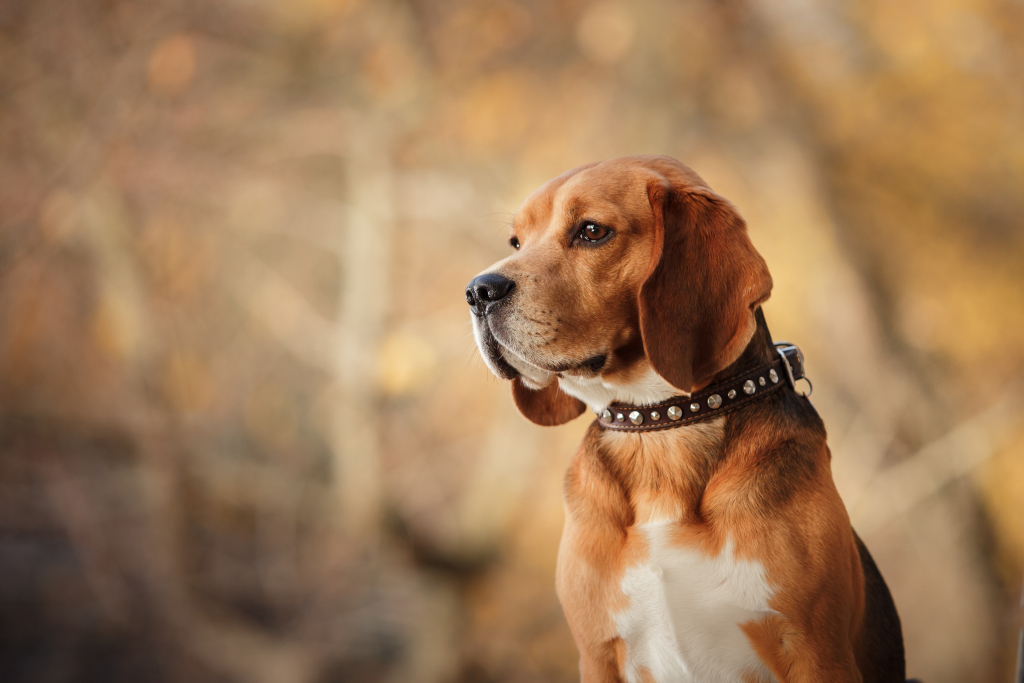
Constantly wagging their tail and sporting a big, dopey grin, Beagles are hard not to love! They are wonderful, lovable dogs, and with their happy-go-lucky attitude, it’s easy to see why they’re one of the most popular breeds. However, they’re not the right breed for everyone. Here’s a quick summary of what you need to know before getting a Beagle.
First and foremost, Beagles require lots of exercises. They are a high-energy breed that needs at least an hour of vigorous exercise daily. Without it, they can become restless, depressed, and destructive.
Also, remember Beagles are hunting dogs and have a strong prey drive. As such, they may not be the best choice for homes with small pets. And led by their nose, they can easily become distracted and may try to escape in search of something interesting they’ve caught a whiff of.
They are also known to be very vocal dogs. Beagles bark and howl…a lot, and they’ll do so at the drop of a hat. They can be quite persistent about it, too, which some people may find disruptive and may not be welcome in apartments or by neighbors as a result.
Additionally, these compact hounds are not the easiest breed to train. They are stubborn, determined, and prefer to follow their nose rather than listen to their owner, especially if there’s something more interesting going on. That’s not to say they can’t be trained, but it will take patience, consistency, and lots of treats, and be prepared for some frustrating moments along the way.
So, before you get a Beagle, really think about whether or not they are the right breed for your lifestyle and personality. If you think you can handle all that, then go ahead and add one of these lovable hounds to your family. They are sure to bring loads of joy into your life!
Buying a Beagle From a Breeder
If you’re interested in buying a Beagle, it’s essential to do your research and find a reputable breeder. Because unfortunately, there are many backyard breeders and puppy mills that produce unhealthy and poorly-bred dogs. So make sure to take the time to find a responsible breeder who puts their dogs’ health and wellbeing first.
The price of a Beagle puppy varies depending on the individual dog’s lineage, but generally, you can expect to pay anywhere from $500 to $2000. And when looking for a Beagle breeder, ensure you ask a lot of questions and get as much information as possible. For instance:
- How long have you been breeding Beagles?
- Will the puppies be AKC registered?
- Do you have any references I can speak to?
- Can I see the parents of the puppy I’m interested in?
- Are the puppy’s parents health-tested and current on all their vaccinations?
- Do you provide a health guarantee?
- Do you offer any support after I take my puppy home?
These are just some of the questions you should ask, and feel free to add anything else you may be curious about, whether it’s about the breeder’s experience, the Beagle puppies, or the Beagle breed in general. Responsible breeders will be able to and be more than happy to answer your questions.
And always follow your gut instinct. If you don’t feel comfortable with the breeder for any reason, it’s probably best to look elsewhere. Don’t ever feel pressured into buying the puppy or be afraid to walk away from the deal, no matter how good it may seem. Because at the end of the day, you want to ensure that you’re getting a healthy, happy pup.
Not sure where to look?
Many great resources are available online to help you find a good Beagle breeder. The American Kennel Club (AKC) marketplace is an excellent place to start, as they have a list of AKC-registered breeders on their website. Or you can check out the National Beagle Club of America’s website for a list of breeders in your area.
Adopting a Beagle From a Rescue or Shelter
Another way to get a Beagle is to adopt one from a rescue organization or shelter. This can be a great option if you’re not set on a particular age, color, or gender of Beagle, and it’s also a great way to give one of these sweet dogs a second chance at life.
There are many Beagle rescues and shelters across the country, so you should have no trouble finding one near you. However, if you need help getting started, you can check out the sites below:
When adopting a Beagle, be prepared to go through an interview process with the rescue organization or shelter. They will want to ensure that you’re a good fit for the dog and that you’ll provide them with a loving home.
You will also be asked to pay an adoption fee. The fee will vary depending on the rescue or shelter, the dog’s age, etc., but it typically ranges from $300-$500. This helps cover the cost of transportation, medical care, and food for the Beagle while they were in the shelter’s care.
Facts About Beagles That You Probably Don't Know
- Beagles have starred in the popular cartoon, Peanuts. (Snoopy is a Beagle!)
- Beagles were originally bred for hunting.
- Beagles’ white-tipped tail is to help hunters locate them when out in the field.
- Beagles’ floppy ears help them trap scent particles and direct them to their nose.
- Beagles have 225 million scent receptors, making them superb sniffers. And as a result of that, they’re often used in law enforcement. Also, they are capable of detecting lung cancer in humans with up to 97% accuracy!
- There’s even a Beagle Brigade at the US airports that help to sniff out food and agricultural products that are not allowed into the country.
- President Lyndon B. Johnson had two famous Beagles – Him and Her.
- Sadly, Beagles are the most used breed for experiments, research, and animal testing.
- Beagles can vocalize in three ways: howling, baying, and barking. And… Here’s the howling Beagle in all her glory!

